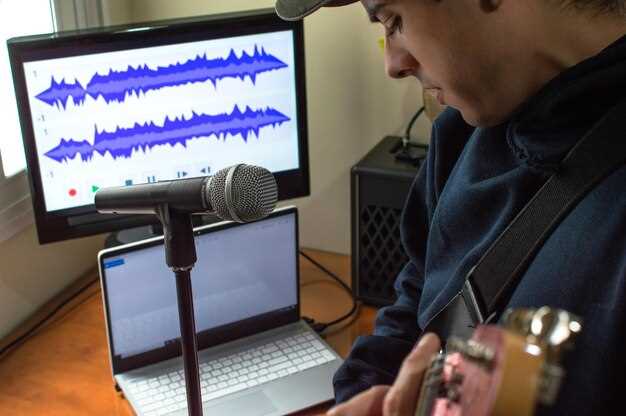Leverage the power of sonification in transforming complex data into auditory experiences. This technique offers an innovative approach to data interpretation, making it accessible to a broader audience. Sonification involves representing data through sound parameters such as pitch and rhythm, which helps in identifying patterns and anomalies that might not be discernible in visual formats.
To effectively use sonification, focus on the type of data and the intended outcome. Start with quantitative data that naturally translates into sound, such as financial statistics or scientific measurements. Choose sound parameters that align with your data characteristics for a meaningful representation. For example, represent rising temperatures with an increasing pitch while using volume to highlight critical thresholds.
Additionally, tailor your sound choices to your audience’s proficiency. Consider using familiar and intuitive sounds that enhance comprehension. Implement feedback mechanisms to refine your sonified outputs based on listener input, ensuring a cycle of continuous improvement. Intersperse varying sound dynamics to maintain engagement and avoid listener fatigue. By carefully selecting and adjusting your sounds, you can provide a unique and powerful method for data analysis and storytelling.
Methods and Techniques for Data Sonification

Start with parameter mapping, a method that directly converts data elements into specific sound parameters such as pitch, volume, and timbre. For instance, mapping a data range of 1 to 10 to MIDI notes can create a scale from C4 to C5. This method promotes clarity by creating intuitive associations between data and sound characteristics.
Consider employing auditory icons–sounds that evoke everyday auditory experiences, like the sound of raindrops to represent data points. This technique is particularly effective when the dataset includes natural phenomena and benefits listeners with clear contextual knowledge.
Earcons offer another approach, which involves abstract musical phrases representing data events or categories. Companies often use this method to convey complex data states through recognizable sound sequences. This works well for recurring patterns or alerts within the dataset.
Utilize model-based sonification, where you take advantage of system dynamics to generate sound. This technique is effective for datasets with inherent interactive properties, as it allows users to sonically explore data through dynamic interaction, such as manipulating a virtual object to hear feedback.
Experiment with threshold-triggered sounds to highlight specific data conditions–like alerts for exceeding safety limits. This method is invaluable for monitoring systems where immediate action is necessary. Choose distinctive sound cues to ensure prompt recognition and response.
Enhance listener immersion by incorporating spatialized sound, where different data streams are positioned in a virtual three-dimensional space. This technique can increase engagement by creating an immersive environment, especially useful in applications like virtual reality.
Combine techniques for hybrid sonification, where integrating multiple methods can offer a more comprehensive representation of data. For example, parameter mapping might be used alongside earcons in a complex dataset, providing users with both detailed data insight and general categorical information.
Finally, always test the sonification design with various demographics to ensure that your method communicates effectively across different user groups. Gathering diverse feedback aids in refining the sounds for clarity and effectiveness. Prioritize usability and context awareness to produce meaningful auditory experiences.
Mapping Data to Auditory Parameters
Begin by selecting appropriate auditory parameters to represent different aspects of your data. Frequency, amplitude, tempo, and timbre serve as versatile mappings for various data characteristics. Assign frequency changes to continuous data values, such as temperature or stock prices. Utilize higher frequencies for increasing values and lower frequencies for decreasing ones to create an intuitive sonic experience.
Amplitude modulation effectively communicates magnitude. For large data sets, link amplitude to reflect intensity; a low amplitude for small values and a high amplitude for large values provides clear auditory contrast. Ensure the dynamic range is perceptually meaningful to avoid overwhelming the listener.
Tempo changes can represent temporal variations. For cyclical or time-sensitive data, faster tempos can signal rapid changes, while slower tempos suggest steadiness. Adjust the tempo to match the data interval–daily, weekly, or monthly–to accommodate the listener’s pace of data consumption.
Timbre offers a unique dimension for categorical data representation. Assign distinct instrumental sounds to different categories, such as sectors in financial data or departments in organizational data. The human ear distinguishes between timbres more effectively than subtle pitch differences, increasing clarity when differentiating between categories.
| Data Type | Auditory Parameter | Suggested Use |
|---|---|---|
| Continuous | Frequency | Map to data value directly for intuitive scaling |
| Magnitude | Amplitude | Use to reflect intensity, ensuring clear contrast |
| Temporal | Tempo | Adjust to signal speed or pacing of change |
| Categorical | Timbre | Assign distinct sounds for easy classification |
Consistently test and refine these mappings with your target audience, focusing on usability and comprehension. Address common listening environments and potential accessibility needs to ensure the sonification is universally clear and effective.
Choosing Suitable Sound Technologies for Different Data Types
Adopt MIDI-based technologies for numerical data visualization. MIDI controllers offer precise control over musical elements, making them ideal for representing numerical parameters like weather statistics or financial trends through note sequences or dynamics.
For temporal datasets, such as stock market fluctuations or web traffic, harness audio synthesis libraries like SuperCollider. These libraries are equipped to generate real-time audio, providing dynamic feedback as the dataset evolves, perfect for streaming data representations.
Turn to wavetable synthesis when dealing with categorical data. This allows for distinct sound modulation across different categories, offering unique audio signatures for each data class. Tools like Ableton Wavetable are well-suited for creating these rich soundscapes.
Integrate granular synthesis to handle large-scale datasets that require detailed analysis. Granular tools, such as Max/MSP, can process vast data into granular textures, offering both macro and micro-level listening experiences that reveal intricate data patterns.
Use sonification software like Pure Data for spatial data, enabling spatialized audio rendering. Such technology supports 3D audio representation, ideal for geographic data or virtual environment exploration, enhancing user immersion through positional audio cues.
Finally, leverage human voice synthesis for text-based data using tools like Vocaloid. By converting textual information into speech or singing, this approach engages audiences through a familiar medium, making it suitable for accessibility applications or narrative data presentations.
Handling Complex Data Structures in Sonification
Optimizing your sonification of complex data begins with determining the key variables that need representation. Identify the most critical components and consider how they relate to each other. For instance, when sonifying multidimensional datasets, you might map each dimension to different sound parameters such as pitch, volume, or rhythm.
To effectively manage large datasets, normalize your data to reduce variability. This step ensures that your auditory display is interpretable and not overwhelming. Consider implementing thresholding techniques that allow only the most significant data points to influence the sound, thus maintaining clarity.
Avoid clutter by using hierarchical auditory layering. For example, background sounds can represent less critical data, while foreground sounds can highlight the important aspects. This creates a perceptual priority, ensuring that significant data is easily discernible.
When dealing with temporal data, leverage sequencing methods to portray changes over time effectively. Synchronize auditory patterns with data trends, using repeated motifs to signal recurring data phenomena. This method helps users intuitively grasp the temporal dynamics of the dataset.
If your dataset encompasses spatial information, consider spatial audio techniques. Utilize binaural audio to simulate spatial positions, helping users intuitively understand spatial relationships within the data. This approach enhances listeners’ ability to ‘navigate’ complex data environments.
Testing with varied user groups can provide insights into how comprehensible and intuitive your sonification is. Collect feedback iteratively and adjust parameters to improve data comprehension without sacrificing audio quality. By prioritizing user experience, you create a more accessible and informative sonification.
Designing User-Friendly Audio Interfaces
Prioritize intuitive navigation by implementing clear and straightforward controls. Users should immediately understand how to interact with the interface without extensive instructions. Utilize familiar icons and ensure tactile feedback is responsive and consistent, aiding in accessibility for users with different needs.
Balance complexity and simplicity by offering advanced options and customization settings in a separate section. This approach caters to both novice and experienced users, allowing them to interact with the interface at their own comfort level.
Incorporate real-time feedback to enhance user interaction. Auditory cues such as subtle beeps or tones upon successful actions can reinforce positive interaction, while error sounds should gently guide users back to the correct path without causing frustration.
Ensure sound quality is top-notch and free from distortions. Poor audio can lead to misinterpretation of data. Implement audio testing processes that cover various scenarios and environments, ensuring consistency and clarity across different devices.
Consider cultural and social factors in sound design. Recognize that sound interpretations can vary greatly, so choose audio cues that are universally understandable or provide options for customization to fit local contexts. This enhances global usability and user satisfaction.
Integrate feedback loops by continuously gathering user feedback to refine and improve interface design. Encourage users to share their experiences and insights, using these to adapt the interface to meet evolving user needs effectively.
Finally, focus on inclusive design practices that accommodate users with hearing impairments. Provide visual alternatives where possible, like visual indicators synchronized with audio signals, ensuring a seamless experience for all users.
Applications and Challenges in Data Sonification

One effective application of data sonification is in the field of scientific research where it enhances data analysis by making intricate datasets audible. For instance, astronomers convert radio signals from space into sound to identify patterns that remain undetected visually. Scientists can distinguish between different cosmic entities by the distinctive audio signatures they produce.
In healthcare, sonification transforms complex patient data into sound to monitor vital signs or detect anomalies in real time. The rhythmic audio patterns offer medical professionals instant feedback about a patient’s state, improving response times during critical situations.
Education benefits from sonification as well, particularly in assisting visually impaired individuals. Converting graphs and charts into soundscapes allows these learners to access and comprehend data independently, fostering inclusivity in education.
Music composition also embraces sonification where composers use data streams to inspire and create novel compositions. Weather patterns, stock market fluctuations, or even social media trends serve as unconventional inputs for generating dynamic musical pieces.
Despite these promising applications, sonification faces several challenges. One major obstacle is ensuring the accurate representation of data through sound without distorting or oversimplifying information. It’s essential to maintain data integrity while creating intuitive acoustic mappings.
Another challenge is the subjective nature of sound perception. Different listeners might interpret auditory cues differently, leading to potential miscommunications. Establishing standardized auditory cues could mitigate this issue, but it remains a significant hurdle.
Moreover, the integration of sonification into existing systems often requires overcoming technical barriers. It’s crucial to balance computational resources to avoid latency and ensure seamless auditory feedback, especially in real-time applications.
Finally, there’s a need to enhance user training in interpreting sonified data correctly. Educating users on effectively navigating auditory displays can maximize the benefits of sonification and prevent data misinterpretation.
Utilizing Sonification in Scientific Research
Apply sonification techniques to explore complex datasets more intuitively. Begin by identifying key data attributes that can be mapped to auditory parameters such as pitch, tempo, or volume. This approach allows researchers to perceive patterns and anomalies in data through auditory channels, offering alternative insights that visual graphs may not reveal. Use sound to represent time-series data, facilitating the detection of trends or recurring patterns that can indicate underlying scientific phenomena.
Consider employing sonification in fields like meteorology to transform weather data into auditory formats. This technique can help researchers quickly grasp fluctuations in weather patterns, temperature changes, or atmospheric pressure variations over time. For instance, different pitches can indicate temperature ranges, while rhythm changes might represent pressure variations.
Encourage the use of sonification in neuroscience by converting neural signals into sound. This method assists in monitoring brain activity patterns, providing an additional layer for analyzing neural responses during experiments. Researchers benefit from real-time auditory feedback, enhancing the monitoring process of cognitive or emotional activities.
Integrate sonification into ecological studies to audibly monitor ecosystem dynamics. Transforming data from sensors tracking animal movements or environmental changes into sound can facilitate understanding of behavioral patterns and environmental shifts. Researchers might distinguish various ecosystems by their unique ‘soundscapes,’ aiding in conservation efforts.
| Field | Application | Benefit |
|---|---|---|
| Meteorology | Weather data sonification | Quick detection of pattern changes |
| Neuroscience | Brain activity audio feedback | Enhanced monitoring of cognitive patterns |
| Ecology | Ecosystem soundscapes | Insight into behavioral and environmental changes |
Integrating Sonification into Educational Tools
Identify clear learning objectives and align sonification techniques to these goals. By doing so, teachers can ensure that each auditory representation serves a specific educational purpose, such as illustrating mathematical trends or historical timelines.
- Choose Appropriate Data: Select data sets that can effectively translate into sound. For example, scientific phenomena, like climate changes over decades, naturally lend themselves to auditory interpretation.
- Incorporate Interactive Elements: Allow students to manipulate the data sonifications interactively. By altering variables and instantly hearing the results, learners gain an intuitive understanding of complex concepts.
- Provide Contextual Information: Accompany sounds with visual or textual descriptions. This supports students who benefit from multiple learning modalities, enhancing overall comprehension.
- Develop Feedback Mechanisms: Implement systems where students can test their understanding and receive feedback. For instance, quizzes that require students to identify patterns in sonified data encourage deeper engagement.
- Integrate with Existing Technology: Utilize platforms familiar to educators and students, ensuring that sonification tools can seamlessly blend into current curriculums without a steep learning curve.
Evaluate the learning outcomes regularly. Gather feedback from students to refine the approach, ensuring the sonifications remain engaging and educational. Through iterative improvements, sonification can become a powerful ally in education.
Addressing Human Perception Variability in Sonification
Leverage diverse auditory cues to cater to listener differences, as individual perceptions of sound can vary significantly. Utilize distinct timbres, varying pitch ranges, and unique rhythmic patterns to represent data sets clearly to a wide audience.
- Employ Pitch Scaling: Match data points with specific pitch levels that align with natural human auditory perception. This approach ensures a more intuitive understanding, as higher data values relate to higher pitches, which most users find easy to interpret.
- Introduce Timbre Variations: Assign different timbres to distinct data categories to minimize confusion. Consider the psychological impact of sounds; for example, using a warm brass sound might denote growth, while a sharp metallic sound might represent caution or alert.
- Manipulate Rhythm: Utilize rhythm to demonstrate the frequency of data events or spikes. Faster rhythms can signal increased data activity, and sustained notes can indicate stability or lack of change.
Offer user customization options to address individual listening preferences or audiological constraints. For example, providing parameters that allow users to modify the volume or select preferred instrument sounds enhances accessibility and personal engagement.
Incorporate feedback loops through user testing and surveys to identify how diverse audiences interpret the sonified data. Regularly adjust and refine the sonification process based on feedback to optimize clarity and comprehension.
- User Testing: Conduct tests with people of varying backgrounds to gather insights on how different individuals perceive the sonification. The feedback from diverse user groups can highlight common areas of misunderstanding or success.
- Feedback Integration: Use insights from user feedback to fine-tune auditory mappings. If many users find a sound too abrasive, consider adjusting the sound’s frequency spectrum or amplitude.
By prioritizing a varied and user-centric approach, you can transform sonification into a more inclusive and effective tool for communicating complex data.
Overcoming Technological Barriers in Sound Synthesis
Begin by selecting robust software that caters specifically to your sonification needs. Tools like Pure Data and Max/MSP provide flexible environments to create custom sound synthesis algorithms, allowing for precise data-to-sound mappings.
- Optimize Computing Power: Leverage modern computing power by utilizing multi-threaded processing and efficient coding practices. This ensures real-time synthesis without latency issues, crucial when dealing with complex data sets.
- Utilize Open-Source Libraries: Explore libraries such as SuperCollider and Csound. These resources offer pre-built modules and functions that streamline the sound synthesis process, reducing development time and improving sound quality.
- Adopt Efficient Data Handling: Implement data pre-processing techniques to clean and structure data before feeding it into your synthesis system. This reduces computational load and enhances accuracy in sound representation.
- Invest in High-Quality Audio Interfaces: A reliable audio interface enhances output quality and ensures your synthesized sounds are accurately portrayed. Look for interfaces with low latency and high sampling rates.
Maintain clarity in the sound output by thoughtfully designing the mapping between data parameters and sound properties. Avoid overcomplicating the sonification with too many variables, which can lead to confusing results. Prioritize linear mappings as a starting point, then experiment with more complex mappings to enrich the audible data experience.
- Test and Iterate: Regularly test the audio output with target audiences to gather feedback. Iterative refinements based on this feedback lead to more effective sonification.
- Stay Updated: Keep abreast of advancements in sound synthesis technology and methodologies. Engaging with communities and forums focused on sonification can provide insights into overcoming current limitations.
Achieve success by fostering collaboration between data scientists and sound engineers. This interdisciplinary approach harnesses varied expertise, resulting in innovative and meaningful auditory representations of data.
Video:
Data sonification in Visual Process Analytics
Data sonification in Visual Process Analytics
Q&A:
What is sonification, and how does it work in simple terms?
Sonification is the process of converting data into sound. This involves mapping data values to various sound parameters like pitch, volume, and duration. By listening to these sounds, one can interpret the trends or patterns in the data. Essentially, it’s another way of representing data, similar to how data visualization turns data into visuals like charts or graphs.
In what fields can sonification be particularly useful, and why?
Sonification is particularly useful in fields such as medicine, where it can aid in analyzing complicated datasets like EEGs or heartbeats. In aeronautics, it helps pilots by converting crucial flight data into sound, improving situational awareness. It’s also beneficial in data analysis and education, providing an alternative method for interacting with data, which can be especially helpful for visually impaired individuals.
How does sonification help those with visual impairments?
Sonification provides an auditory way of interpreting data, which can be very beneficial for those who are visually impaired. By transforming data into sound, these individuals gain access to the same insights as those who use visual charts. This approach improves inclusivity and accessibility, allowing more people to explore and understand data.
What are some common methods or techniques used in sonification?
There are several common techniques in sonification, including parameter mapping, auditory icons, and earcons. Parameter mapping involves assigning data to various sound properties like pitch or tempo. Auditory icons use familiar sounds to represent data changes, while earcons are abstract musical phrases that convey information. Each technique offers unique ways of understanding and interpreting data through sound.
Can you give an example of a real-world application of sonification?
One real-world application of sonification is in finance, where stock market trends are converted into sound to allow traders to monitor changes without constantly watching a screen. Another example is in environmental monitoring, where sonification can represent changes in weather data, helping researchers quickly detect anomalies like storms or heatwaves.
What exactly is sonification, and how does it differ from simply converting data into sound?
Sonification is the process of converting data into audio signals with the specific purpose of conveying information or data insights through sound. This approach goes beyond merely turning numbers into noise; it aims to represent data in a meaningful and recognizable auditory format. For example, while a basic sound conversion could generate random beeps from a dataset of temperature changes, sonification may use specific tones or patterns to highlight trends, anomalies, or correlations within that data. This can help listeners to perceive complex data relationships, similar to how a data visualization presents information visually.




